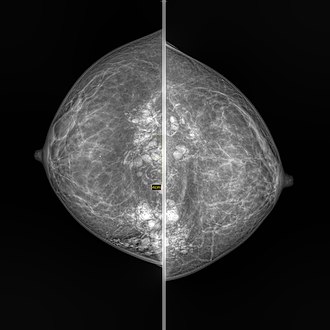Silicone granuloma

Editor-In-Chief: Prab R Tumpati, MD
Obesity, Sleep & Internal medicine
Founder, WikiMD Wellnesspedia &
W8MD medical weight loss NYC and sleep center NYC
| Silicone granuloma | |
|---|---|
| Synonyms | N/A |
| Pronounce | N/A |
| Specialty | N/A |
| Symptoms | Nodule, inflammation, pain, swelling |
| Complications | Infection, scarring |
| Onset | Variable, often months to years after exposure |
| Duration | Chronic |
| Types | N/A |
| Causes | Silicone injection or leakage |
| Risks | Cosmetic surgery, breast implants, silicone injections |
| Diagnosis | Ultrasound, biopsy |
| Differential diagnosis | Lipoma, cyst, lymphoma |
| Prevention | N/A |
| Treatment | Surgical excision, corticosteroids, antibiotics |
| Medication | N/A |
| Prognosis | Variable, depends on extent and treatment |
| Frequency | Rare |
| Deaths | N/A |


Silicone granuloma is a type of granuloma, a specific form of chronic inflammation, that is caused by the injection of silicone. It is a rare but serious complication that can occur after procedures such as breast augmentation or other types of cosmetic surgery where silicone is used.
Causes[edit]
Silicone granulomas are caused by the body's immune response to silicone that has leaked or migrated from a silicone-containing device, such as a breast implant. The body forms a granuloma, or a mass of immune cells, around the silicone in an attempt to isolate it.
Symptoms[edit]
Symptoms of silicone granuloma can vary depending on the location and size of the granuloma. They may include pain, redness, swelling, and the formation of a lump or mass. In some cases, silicone granulomas can lead to serious complications such as skin necrosis or infection.
Diagnosis[edit]
Diagnosis of silicone granuloma is typically made based on the patient's medical history, physical examination, and imaging studies such as ultrasound or magnetic resonance imaging (MRI). In some cases, a biopsy may be needed to confirm the diagnosis.
Treatment[edit]
Treatment of silicone granuloma typically involves removing the source of the silicone, if possible. This may involve surgery to remove a silicone-containing device such as a breast implant. In some cases, medication may be used to reduce inflammation and manage symptoms.
See also[edit]
Ad. Transform your life with W8MD's Budget GLP-1 injections from $75


W8MD offers a medical weight loss program to lose weight in Philadelphia. Our physician-supervised medical weight loss provides:
- Weight loss injections in NYC (generic and brand names):
- Zepbound / Mounjaro, Wegovy / Ozempic, Saxenda
- Most insurances accepted or discounted self-pay rates. We will obtain insurance prior authorizations if needed.
- Generic GLP1 weight loss injections from $75 for the starting dose.
- Also offer prescription weight loss medications including Phentermine, Qsymia, Diethylpropion, Contrave etc.
NYC weight loss doctor appointmentsNYC weight loss doctor appointments
Start your NYC weight loss journey today at our NYC medical weight loss and Philadelphia medical weight loss clinics.
- Call 718-946-5500 to lose weight in NYC or for medical weight loss in Philadelphia 215-676-2334.
- Tags:NYC medical weight loss, Philadelphia lose weight Zepbound NYC, Budget GLP1 weight loss injections, Wegovy Philadelphia, Wegovy NYC, Philadelphia medical weight loss, Brookly weight loss and Wegovy NYC
|
WikiMD's Wellness Encyclopedia |
| Let Food Be Thy Medicine Medicine Thy Food - Hippocrates |
Medical Disclaimer: WikiMD is not a substitute for professional medical advice. The information on WikiMD is provided as an information resource only, may be incorrect, outdated or misleading, and is not to be used or relied on for any diagnostic or treatment purposes. Please consult your health care provider before making any healthcare decisions or for guidance about a specific medical condition. WikiMD expressly disclaims responsibility, and shall have no liability, for any damages, loss, injury, or liability whatsoever suffered as a result of your reliance on the information contained in this site. By visiting this site you agree to the foregoing terms and conditions, which may from time to time be changed or supplemented by WikiMD. If you do not agree to the foregoing terms and conditions, you should not enter or use this site. See full disclaimer.
Credits:Most images are courtesy of Wikimedia commons, and templates, categories Wikipedia, licensed under CC BY SA or similar.
Translate this page: - East Asian
中文,
日本,
한국어,
South Asian
हिन्दी,
தமிழ்,
తెలుగు,
Urdu,
ಕನ್ನಡ,
Southeast Asian
Indonesian,
Vietnamese,
Thai,
မြန်မာဘာသာ,
বাংলা
European
español,
Deutsch,
français,
Greek,
português do Brasil,
polski,
română,
русский,
Nederlands,
norsk,
svenska,
suomi,
Italian
Middle Eastern & African
عربى,
Turkish,
Persian,
Hebrew,
Afrikaans,
isiZulu,
Kiswahili,
Other
Bulgarian,
Hungarian,
Czech,
Swedish,
മലയാളം,
मराठी,
ਪੰਜਾਬੀ,
ગુજરાતી,
Portuguese,
Ukrainian



